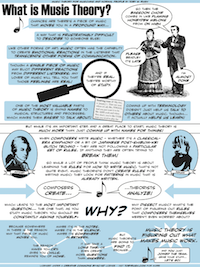
This page contains materials from our music theory sessions. You can download PDF files of the posters we use from Toby Rush's Music Theory for Musicians and Normal People site.
Part 1: Notation
Music notation is the written language that universally conveys both space and time. In the first session, you learn about music notation, just to put us all on a level playing field. You learn about notating:
- Pitch (the five lines, clef, accidentals)
- Rhythm (all those dots and flags)
- Meter (feeling and categorizing the beat)
- Beaming (putting patterns together)
- Complex meter (7/8 of the time!)
Learn more about music notation by reading this book (available on Amazon.com and other places)

Part 2: Scales and keys
In part two, you learn about scales and keys.
- The major scale, and how to build one from a melody
- Half steps and whole steps in a scale
- Key signatures, all those sharps and flats
- The Circle of Fifths
- The minor scale
- Modern modes





Part 3: Intervals
- Diatonic intervals (intervals within the scale) and some melodies to assist your analysis!
- Perfect intervals (why do we call them "perfect"?)
- Imperfect intervals (just to augment the instruction)
- How to analyze and write your own intervals!



 Here's the one page of the score we use to analyze intervals and chords.
Here's the one page of the score we use to analyze intervals and chords.





